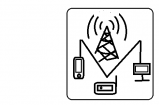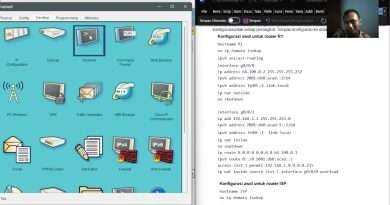Class-12 IPV6 ADDRESSING – Internet protocol version 6 address -learn ipv6 in Hindi & Urdu
Class-12 IPV6 ADDRESSING – Internet protocol version 6 address -learn ipv6 in Hindi & Urdu
IP Version 6 (IPv6), the replacement protocol for IPv4, is well known for a couple of reasons.
IPv6 provides the ultimate solution for the problem of running out of IPv4 addresses
in the global Internet by using a 128-bit address–approximately 1038 total addresses, versus
the mere (approximate) 4* 109 total addresses in IPv4.
However, many articles over the years have discussed when, if ever, would a mass migration to IPv6 take place. IPv6 has
been the ultimate long-term solution for more than 10 years, in part because the interim
IPv4 solutions, including NAT/PAT, have thankfully delayed the day in which we truly run
out of public unicast IP addresses.
#Ipv6 #ipv6address #internet protocol address
Now Get Free Video Courses, E-Books, Event Updates & Class Notes Anywhere Anytime
LEARN ANYWHERE WITH A2IT IOS AND ANDROID APP
https://a2itsoft.com/free-app
A2IT online, free course coupon, free educational video, free course, free training, LAN & WAN, ip addressing and subnetting, ip address classes, ip address, ip address in hindi, CCNP Training in Chandigarh, Networking training in Chandigarh, LAN & WAN with IP address
As more IPv6 deployments continue to emerge, Cisco has steadily added more and more
IPv6 content to its certification exams. CCNA now includes basic IPv6 concepts and configuration,
with this version of the CCNP ROUTE exam examining IPv6 to greater depth
than its predecessor BSCI exam.
In particular, ROUTE includes the basic concepts, configuration,
and verification of most of the router-based tools needed to deploy IPv6 in the
Enterprise. As with most of the other topics, ROUTE’s coverage of IPv6 does not include
all skills and knowledge to plan an Enterprise IPv6 deployment, but it does include
enough to take an IPv6 design plan and make a good start on developing an IPv6 implementation
and verification plan.
For example, consider the following IPv6 address that is assigned to a host on a LAN:
2000:1234:5678:9ABC:1234:5678:9ABC:1111/64
This value represents the full 128-bit IP address–there are no opportunities to even abbreviate
this address. However, the /64 means that the prefix (subnet) in which this address resides
is the subnet that includes all addresses that begin with the same first 64 bits as the
address.
Next, one last fact about the rules for writing prefixes before seeing some examples and
moving on. If the prefix length is not a multiple of 16, then the boundary between the prefix
and the interface ID (host) part of the address is inside a quartet. In such cases, the prefix
value should list all the values in the last octet in the prefix part of the value. For
example, if the address just shown with a /64 prefix length instead had a /56 prefix length,
the prefix would include all of the first 3 quartets (a total of 48 bits), plus the first 8 bits of
the fourth quartet. The next 8 bits (last 2 hex digits) of the fourth octet should now be binary
0s, as part of the host portion of the address.
Stateful DHCP for IPv6
IPv6 hosts can use stateful DHCP to learn and lease an IP address and corresponding prefix
length (mask), the IP address of the default router, and the DNS IP address(es). The
concept works basically like DHCP for IPv4; the host sends a (multicast) packet searching
for the DHCP server.
When a server replies, the DHCP client sends a message asking for a
lease of an IP address, and the server replies, listing an IPv6 address, prefix length, and
DNS IP addresses. (Note that Stateful DHCPv6 does not supply the default router information,
instead relying on Neighbor Discovery Protocol between the client and local
routers.)
The names and formats of the actual DHCP messages have changed quite a bit
from IPv4 to IPv6, so DHCPv4 and DHCPv6 actually differ in detail, but the basic process
remains the same. (The term DHCPv4 refers to the version of DHCP used for IPv4, and the
term DHCPv6 refers to the version of DHCP used for IPv6.)
DHCPv4 servers retain state information about each client, such as the IP address leased
to that client, and the length of time for which the lease is valid. In other words, DHCPv4
tracks the current state of DHCP clients.
DHCPv6 servers happen to have two operational
modes: stateful, in which the server does track state information, and stateless, in which
the server does not track any state information. Stateful DHCPv6 servers fill the same role
as the older DHCPv4 servers, whereas stateless DHCPv6 servers fill a different purpose as
one part of the stateless autoconfiguration process. (Stateless DHCP, and its purpose, is
covered in the upcoming section “Finding the DNS IP Addresses Using Stateless DHCP.”)
One difference between DHCPv4 and stateful DHCPv6 is that IPv4 hosts send IP broadcasts
to find DHCP servers, whereas IPv6 hosts send IPv6 multicasts.
https://www.a2itonline.com
https://www.facebook.com/A2itonline
Views : 446
ipv6




